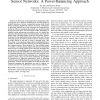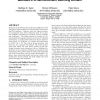380 search results - page 34 / 76 » An Empirical Study of Optimization for Maximizing Diffusion ... |
TON
2010
13 years 7 months ago
2010
—In this paper, we investigate the maximization of the coverage time for a clustered wireless sensor network (WSN) by optimal balancing of power consumption among cluster heads (...
CORR
2010
Springer
13 years 8 months ago
2010
Springer
Abstract--In cognitive radio (CR) networks with multipleinput multiple-output (MIMO) links, secondary users (SUs) can exploit "spectrum holes" in the space domain to acce...
JSAC
2008
13 years 8 months ago
2008
In this paper, we study the theoretical problem of the end-to-end rate assignment for multi-hop wireless networks. Specifically, we consider the problem of joint congestion control...
ICC
2007
IEEE
14 years 3 months ago
2007
IEEE
—Slepian-Wolf coding is a promising distributed source coding technique that can completely remove the data redundancy caused by the spatially correlated observations in wireless...
GECCO
2006
Springer
14 years 9 days ago
2006
Springer
Both genetic algorithms (GAs) and temporal difference (TD) methods have proven effective at solving reinforcement learning (RL) problems. However, since few rigorous empirical com...


